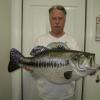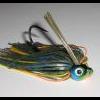I recently picked up a 3rd Rapala electronic scale. I will have one in my bank fishing gear, one in the boat, and the 3rd as a spare. As I always do with a new scale, I perform a pull test on a known weight to check the scale for accuracy and repeatability prior to use. My first two scales have always been very accurate and close to each other during pull tests so I was very interested in how close the 3rd unit would be to the earlier units. So, I tested all three scales at the same time and, for the amusement of BR members, photographed the process.
Test Results:
Measured weight: The test weight was 9.804 pounds (more about how this weight was calculated later).
Unit 1 read: 9.81 pounds - .006 pounds heavy (~0.1 ounce)
Unit 2 read: 9.78 pounds - .024 pounds light (~0.4 ounce)
Unit 3 read: 9.87 pounds - .066 pounds heavy (~ 1.0 ounce)
Exteme spread between the three scales is .09 pounds (~1.5 ounce).
Repeatability: The load was applied to each scale three times. Units 1 and 2 read identical weights each time. Unit 3 read 9.87 twice and 9.85 once.
Photos:
Unit 1 - 9.81 pounds
Unit 2 - 9.78 pounds
Unit 3 - 9.87 pounds
Unit 2 under load - showing the test load - 9.804 pounds
The test load: 420 lead bullets - .40cal/155gr nominal weight (157.63gr actual average weight). Plastic box weighs 2409.0gr. The white string weighs 17.2gr (.039 ounce). I didn't weigh the white label...
Total weight = 68626.3 grains = 9.8037 pounds.
The stated weight of the test load is accurate to within a tiny fraction of an ounce. This is a bit more precise than some folks who have tested their scales using a gallon of water, a 10-pound weight from a bar bell set, or whatever.
NOTE: The measurements are in "grains." This is a somewhat archaic unit of measure used in the U.S. for ammunition components (primarily bullet weights) and for cartridge propellant charges. There are 7,000 grains in a pound, 437.5 grains in an ounce. Propellant charges are typically measured down to 0.1 grain (0.1 grain = ~0.0002 ounce). The scale used to measure the objects in the test weight is accurate and repeatable to within 0.1 grain.
Summary:
I am always amazed at how accurate these scales are; all three scales measure within one ounce of the test weight at the 10 pound range. Load cell technology has certainly improved and the price is now very reasonable for the capability that you get.
I am also amazed at how many people report poor results with this model of Rapala scale. My Unit 1 is now three years old, Unit 3 is brand new; there certainly seems to be consistency in the accuracy of units produced over the past 3 years.
I think knowing the weight of a 10-pound class fish within an ounce is close enough for me. It is extemely unlikely that I will ever come close to a record fish in my water so having a scale that is eligible for certification is unimportant. Compactness, and the ability to read to 50lbs IS important and these little scales work just perfect for me. Replace the battery once a year, don't drop the scale or dunk it in the lake, and you're good to go.
Note for Users:
This load test was conducted with the scales supported by a rigid bench, with the scales oriented vertical to assure that the chain is not rubbing on the scale housing, and with a static test load. When hand-weighing a fish on the water, it's difficult to keep the scale vertical, and to keep the fish immobile. I believe that these two factors are what contribute to variances in weight reading in the field.



